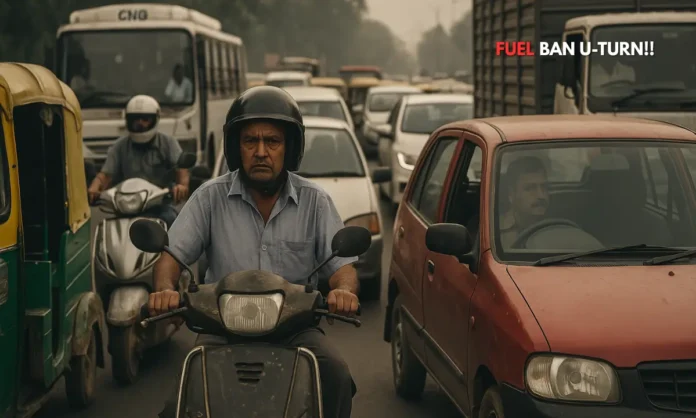SUMMARY
- Delhi government suspends its controversial order banning fuel for 10-year-old diesel and 15-year-old petrol vehicles after massive public backlash.
- Hundreds of vehicles were impounded within days of enforcement; process for recovery now includes penalties and NOCs.
- Technological and enforcement hurdles—including faulty ANPR cameras—prompted the government to rethink its anti-pollution strategy.
The Fuel Ban That Backfired: Why Delhi Put Its EOL Policy on Hold in Just 72 Hours
In a dramatic policy reversal, the Delhi government has halted its enforcement of the End-of-Life (EOL) vehicle fuel ban, just three days after it came into effect on July 1. The decision—meant to curb air pollution by barring fuel access to 10-year-old diesel and 15-year-old petrol vehicles—was met with widespread criticism and confusion, especially from middle-class families and daily wage earners who rely on aging two-wheelers and compact cars.
The backlash was immediate. By the end of Day 1, authorities had impounded more than 75 vehicles, including high-end four-wheelers and two-wheelers, many of which were still functional and regularly maintained. Most of these are now lying in Scrap Yard No. 5 at Sarai Kale Khan, awaiting formal recovery.
The public outrage, paired with technical failures in the enforcement mechanism, forced Chief Minister Rekha Gupta to intervene. On Thursday, she announced a pause on the fuel-ban order and wrote to the Commission for Air Quality Management (CAQM) requesting a formal review.
Delhi’s attempt to enforce green governance has once again collided with on-ground feasibility and public anxiety, raising hard questions about how to balance environmental urgency with economic reality.
Around 62 lakh vehicles out of total of 80 lakh are End of Life (EOL) as per Air commission body- 15y / 10y old.
— KM_ KM (@KnKsnKarn) June 28, 2025
These will be DENIED FUEL from July in city of Delhi, and impounded per Govt order
Most would be running quite well.
Will delhiites rev0lt or accept meekly ? pic.twitter.com/W1A3CtpFTT
What Went Wrong: Tech, Timing, and Trust Deficit
- ANPR cameras, key to identifying banned vehicles, failed due to glitches and poor placement.
- Adjacent NCR states lack ANPR integration, leading to enforcement loopholes.
- Even newer vehicles with High Security Registration Plates (HSRP) couldn’t be reliably scanned.
- Daily commuters and small traders were caught off guard, with no grace period or appeal mechanism.
The core idea behind the fuel ban was straightforward: deny polluting vehicles fuel, and they’ll be forced off the roads. But the execution was anything but. ANPR cameras—tasked with reading number plates and identifying banned vehicles—struggled to detect even legally compliant vehicles post-2019, thanks to inconsistencies in HSRP recognition.
Moreover, the absence of ANPR infrastructure in neighbouring states like Haryana and Uttar Pradesh allowed banned vehicles from those regions to enter Delhi undetected, making the policy ineffective at best, and arbitrary at worst.
The Transport Department’s scrapping campaign may have been well-intentioned, but its execution exposed a critical disconnect between policy design and ground-level preparedness.
How to Get Your Impounded Vehicle Back: The 8-Step Process
- Submit an application to the Transport Department for release.
- The Scrapping Cell verifies ownership and vehicle life.
- For Delhi-NCR vehicles, choose to either:
- Shift it outside Delhi-NCR (requires NOC), or
- Privately park it within Delhi (proof required).
- Out-of-state vehicles must explain their presence in Delhi.
- If approved, a provisional release order is issued.
- Pay the penalty:
- ₹10,000 for four-wheelers
- ₹5,000 for two-/three-wheelers
- Receive a final release order.
- Vehicle returned to owner—but cannot be driven within Delhi.
This process is not only burdensome—it also costs both time and money, especially for those whose vehicles were impounded with no prior warning or alternate transport arrangements. The enforcement penalties have become another unintended tax on the lower middle class, disproportionately affecting those without resources to replace or relocate their vehicles.
Balancing Air and Equity: What the Delhi Government Must Consider Next
- CM Rekha Gupta promises a “revised framework” that balances pollution control with citizen welfare.
- Environment Minister Manjinder Singh Sirsa confirms exploration of new tech-based alternatives beyond unreliable ANPR systems.
- Policy rethink will likely consider phased enforcement, scrappage incentives, and grace periods for compliance.
This suspension is more than a policy correction—it’s a moment of reckoning. Delhi’s air quality crisis is undeniable. But fighting it with blunt instruments risks public goodwill, especially when technology malfunctions and enforcement lacks transparency.
The government now plans to explore a multi-layered model that might include vehicle retirement incentives, better public transit integration, and more robust tech systems. But success will depend on two missing pillars: public consultation and infrastructure readiness.
A Pause, Not a Rollback
For now, Delhi’s fuel ban on EOL vehicles is paused—but not cancelled. The Scrapping Cell remains operational, and vehicles seized between July 1–3 must still go through the recovery process. The policy remains on the books, pending review by the CAQM.
This episode is a reminder that climate action cannot be top-down alone. It needs systems, safeguards, and empathy. And while cleaner air is a non-negotiable goal, so is the need for public trust in how we get there.


